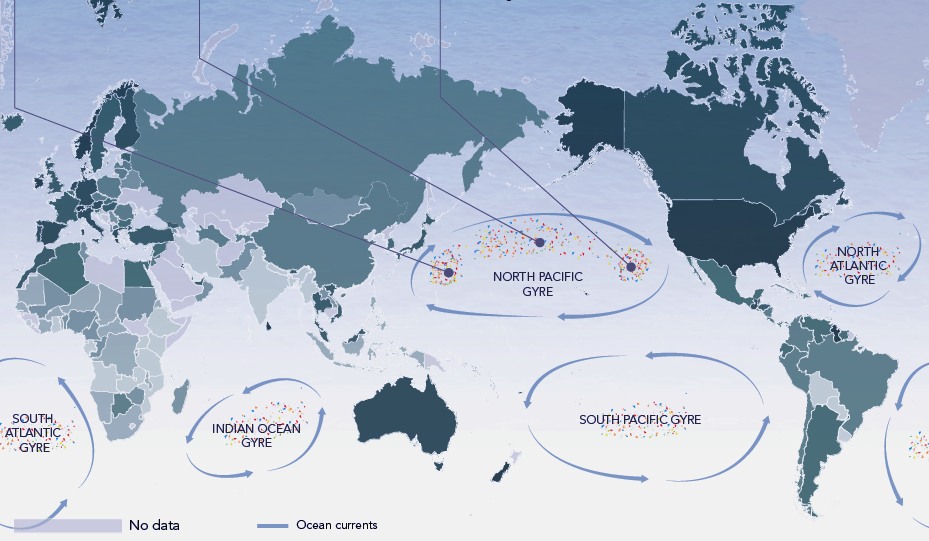 |
| Toxic chemicals can make their way up the food chain from plastic-ingesting marine species into human diets. Source. |
Plastic as a sink for toxic chemicals
Plastic can act as a sink when it adsorbs toxic chemicals in the ambient seawater. These chemicals include persistent, bioaccumulative and toxic substances (PBTs), dichlorodiphenyltrichloroethane (DDT), polychlorinated biphenyls (PCBs), and persistent organic pollutants (POPs). PBTs, DDT, PCBs and POPs present a health concern to humans and the environment. The chemicals can be released into the oceans through pesticides, industrial processes, leaching, or being released from objects into the environment. The interactions between plastic and chemicals in the ocean is complex, but it is more likely than not that PBTs will preferentially sorb to plastic debris, as they have a low water solubility.
Resin pellets (or nurdles) are the raw material used to make plastics in industry. Mato et al. (2001) studied 4 sites on the Japanese coast, examining PCBs, and DDE (a DDT derivative) in polypropylene resin pellets. The concentrations found in the resin pellets were equivalent to that of the seawater and sediments where they were found. A control experiment measured the absorption of virgin resin pellets, finding a regular and significant increase in PCBs and DDE concentration with exposure to the seawater. Mato et al. (2001) showed that the source of PCBs and DDE in the resin pellets was the ambient seawater, as the pellets absorb the chemicals through a process of enrichment.
 |
| Plastic resin pellets act as a sink for toxic chemicals in the ocean. Source. |
Plastic as a source for toxic chemicals
Plastic act as a source for toxic chemicals due to the compounds added during manufacture to give the plastic certain desirable properties, such as pliability. When the plastic is ingested, the chemicals can leach from the plastic directly into the organism. Here are some examples of the chemicals:
- Phthalates. Added to PVC for softness and pliability.
- Bisphenol A (BPA). A monomer used to make polycarbonate plastics. Can have toxic and biological effects on humans.
- Brominated flame retardants. Added to reduce flammability.
With all the added chemicals, plastic debris has the potential to be a source of toxic chemicals for months or decades.
In a study of 12 short-tailed shearwaters collected from a research trawler in the North Pacific Ocean, Tanaka et al. (2013) demonstrated that chemicals are not only transferred to the birds from prey but also from ingested plastics. The abdominal fat tissue of the birds was analysed for polybrominated diphenyl ethers (PBDEs), a POP which is added as a flame retardant. 6 lanternfish and 1 squid were also collected and analysed, being common prey for the birds. In 9 of the 12 birds lower-brominated congeners were the dominant form of PBDEs found. The lower-brominated congeners were also dominant in the prey, indicating accumulation through the food chain. However, in the other 3 birds higher-brominated congeners were dominant - this doesn't match the profile of the prey. Plastics can provide the answer here. Higher-brominate congeners are present in plastics, including those found in the stomachs of the 3 birds. The results indicate that ingestion of plastic is the likely source of the higher-brominated congeners.
 |
| Plastic debris acts as both a sink and a source for toxic chemicals. Source. |
Interactions between plastic, toxic chemicals and the food chain
There are 3 key terms to know about the interaction between toxic chemicals and the food web:
- Bioconcentration. Species living in chemical polluted waters concentrate the chemicals in their tissues
- Bioaccumulation. Species face exposure to toxic chemicals from bioconcentration and ingestion. If the exposure is occurring faster than the chemicals can be eliminated, this is bioaccumulation.
- Biomagnification. Chemicals are found in progressively higher concentrations in progressively higher trophic levels in the food chain.
 |
| Biomagnification of toxic chemicals up the food chain. Source. |

















